Trudy J. Morgan-Cole's Blog, page 8
January 27, 2025
The Scarlet Letter, by Nathaniel Hawthorne, and Hester, by Laurie Lico Albanese

Next up in 2025: another classic novel/modern re-telling pair of books. Rereading The Scarlet Letter (another book I read in university and not since) was not as fun as rereading The Adventures of Huckleberry Finn was, and I will confess to skimming some of Hawthorne’s long passages of description and fairly purple prose. However, as I’m currently spending a lot of my time researching 17th century Puritans, it was a timely re-read.
I thought Laurie Lico Albanese’s novel Hester was a retelling of The Scarlet Letter from Hester’s point of view, but it’s not. It’s a creative re-imagining of how Hawthorne might have been inspired to write the novel. A (fictional) young Scotswoman named Isobel, descended from a long line of women who might possibly be witches, or at least have some unexpected powers, comes to Boston with her husband and meets the young Nathaniel Hawthorne. A friendship develops between them while Isobel’s (pretty awful) husband is away at sea, leading to drama, suspense, and heartbreak … and, indirectly, to the writing of The Scarlet Letter, with the premise that Isobel was the muse who inspired Hawthorne’s creation of Hester. It was an enjoyable read even if it wasn’t quite what I was expecting.
The Adventures of Huckleberry Finn, by Mark Twain, and James, by Percival Everett
The first two books I read in 2025 were the classic The Adventures of Huckleberry Finn, which I read in university and have not returned to in at least 35 years, maybe longer, and James, Percival Everett’s retelling of that story from the perspective of Jim, the escaping enslaved man who shares Huck Finn’s picaresque journey down the Mississippi by raft.
First: the original. Huckleberry Finn is in many ways a hard read for a twenty-first century reader, not just because of the ubiquitous use of the n-word but because of the never-questioned assumption that Jim and few other Black characters in the story are less intelligent, less capable, and less motivated than white characters — even though Jim has seized agency in his own life by running away. The novel is a pointed critique of the racism that Huck has been born into, forcing Huck to accept that helping Jim escape is the more moral action though his society has told him that “stealing” an enslaved person from a white person is theft. However, Mark Twain was, like all of us, a person of his times, and even as he was critiquing and interrogating racism, he was also accepting and perpetrating it. Within this framework, Huckleberry Finn is still quite an engaging read and an interesting character study and social satire — until the last few chapters when Tom Sawyer shows up, Twain obviously feels he needs to bring back his most popular character with all the Tom Sawyer hijinks, and the whole plot gets derailed.
The recent novel James by Black American writer Percival Everett flips the story and tells it from “Jim’s” — James’s — point of view, undermining Twain’s and Huck’s assumptions about Black intelligence and ability. In Everett’s retelling, the qualities that define the enslaved Black people in Huck Finn’s world as stupid and lazy — including the “Negro dialect” that Twain renders both painstakingly and painfully — are cloaks consciously put on to pacify white people and keep them from being alarmed, since white people get dangerous when they are alarmed. It’s in the interests of enslaved people, as James teaches those around him, to pretend to be dumber and less capable than they are, as long as their lives depend on the capricious whims of white enslavers.
Once James escapes and the story gets moving, there’s the familiar pleasure of hearing a different perspective on a well-known story. Everett sticks to Twain’s plotline for some parts of the novel and goes in entirely different directions in other parts (the entire ending deviates from the original novel, which given how bad the ending of the original is, can only be an improvement). If I wanted anything different from James, it was simply more — I wanted the novel to be longer, to give us more of James’s backstory and more of a hint of his future. There’s one particular piece of backstory revealed in the novel which, while believable, absolutely demands (for me) more explanation and perhaps some flashbacks to put it into context — but I’ll say no more for fear of spoilers.
Rereading Huck Finn and then reading James was an enjoyable and thought-provoking experience.
January 3, 2025
Best Books of 2024

Here’s my 2024 list (that’s books I read this year — they weren’t all published this year, though several were) is very varied, and a bit arbitrary. It’s so hard to pick ten out of nearly a hundred books, most of which I enjoyed and many of which I absolutely LOVED.
I’ve been doing this for many years, and I used to do it in more of a “countdown” style, from number 10 to number 1 … but that doesn’t feel honest to me anymore. I love different books for different reasons. When I look back at “Top Ten” lists from previous years, some of them are books that still linger with me and probably always will, while others haven’t stood the test of time nearly as well.
So now I just look through all the books I’ve read during the year (you can find reviews of almost all of them, except for re-reads, by scrolling through the last 12 months of posts right here on this blog). Here are the ones that I think will stay with me longest — not ranked in any way, but listed in the order I read them chronologically throughout the year, with links to my brief reviews/responses on them.
The Rachel Incident, by Caroline O’Donoghue (bonus content: here’s a podcast episode of me and my daughter Emma discussing this novel in detail and comparing it to another novel that we liked much less).Come and Get It, by Kiley ReidFunny Story, by Emily HenryEyes in Front When Running, by Willow Kean (local author!)Vigil, by Susie Taylor (local author!)North Woods, by Daniel MasonCecily (link also includes a review of its sequel, The King’s Mother, which I loved too), by Annie GarthwaiteThe Ministry of Time, by Kaliane BradleyBlood in the Machine, by Brian Merchant (unusually, the only non-fiction title on this year’s list)Martyr! by Kaveh AkbarDecember 30, 2024
Martyr! by Kaveh Akbar

This is a much-hyped book that I’ve heard many people recommend but wasn’t 100% sure I’d like. I’m certainly glad my hold at the library came through and I took a chance on it, because I devoured this novel.
Martyr! is the story of Cyrus, a young Iranian-American poet in his late twenties, recently clean and sober, trying to figure out whether there’s any point or purpose in his life. His childhood was shaped by his mother’s tragic death on Iran Air Flight 655, a passenger flight shot down by US missiles. His father, emigrating with baby Cyrus to the US, allowed his life to be swallowed up by grief and hard work, and died soon after Cyrus started college. Emerging from a childhood marked by loss and young adulthood swallowed up by addiction, Cyrus becomes fascinated with the concept of martyrdom — not so much religious martyrs, as those who give their lives for a person or cause they believe in. He has a vague plan to write a book of poems about martyrs, but what he’s really searching for is the idea of meaning — whether life, or death, can have meaning. His mother’s death was the definition of a meaningless death; Cyrus wants to know what kind of death (including, possibly, his own?) might be meaningful.
The writing here is beautiful, the ideas big and worth exploring. I think a lot of people’s perception of how much they enjoyed this book is tied up in how they felt about Cyrus as a character. If a reader finds him whiny and self-absorbed, as a few reviewers I’ve read did, they probably won’t like this book. I personally loved Cyrus from the first pages and wanted only good for him, so for me it was a completely engaging and absorbing read.
As for whether Cyrus finds meaning, in life or in death … the ending of the book has the kind of intentional vagueness that irritates a lot of readers (and sometimes irritates me!), ending with a scene that begins rooted in realism but turns metaphorical and can be read in a number of different ways. This feels completely intentional on the author’s part: there’s more than one way to interpret the outcome of Cyrus’s quest, because it is, after all, a story. I felt like the author was inviting me to participate in imagining the ending.
I think this will turn out to have been one of my favourite books this year.
December 28, 2024
The Berry Pickers, by Amanda Peters
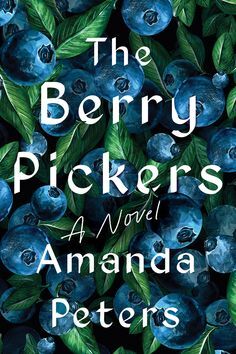
The Berry Pickers of the title are a Mi’kmaq family who, along with many other Mi’kmaq people from Nova Scotia, make an annual trip to Maine in the early 1960s to pick blueberries. The early chapters of the novel give a sense of how this migratory work is an important piece of their lives and we get a feeling for the community that forms among these migrant workers. The family at the centre of the story is close-knit and for the most part happy, though the residential schools (which some of their children previously attended) lurk in the background as a constant thread.
A threat they are not expecting, however, strikes during a berry-picking trip in 1962, when the family’s youngest child, Ruth, disappears. No trace of her is ever found, and the family returns home, wounded by this terrible loss.
The novel is narrated partly by Joe, the brother closest to Ruth in age and the one who feels responsible for her disappearance because he wasn’t watching her at the moment when she wandered off (Joe is six and Ruthie is four at the time). The other narrator is a seemingly unrelated girl called Norma, but it doesn’t take the reader long to realize that Norma is in fact Ruthie, alive and well but growing up in a completely different world, unaware of who she really is or where she came from.
The two siblings’ stories continue on parallel lines for much of the novel as Joe tries to exorcise his guilt and grief, while Norma tries to make sense of the contradictions in her family life and her childhood memories. I found this an intriguing and satisfying book to read.
Remarkably Bright Creatures, by Shelby van Pelt
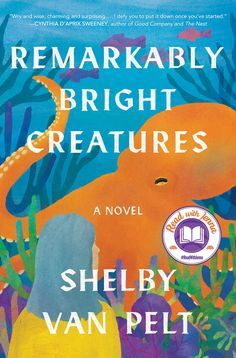
Part of a growing trend (that hopefully will grow even more) of novels featuring personal growth and maybe even a little romance for characters over 60, Remarkably Bright Creatures is the story of Tova, an elderly woman who could afford to retire but keeps her job as a cleaner at an aquarium because keeping busy helps her to cope and feel useful. Tova is grieving the death of her teenaged son 30 years ago and the more recent loss of her husband. Although she has a close-knit group of friends, she has difficulty trusting or opening up to people. But she has an unlikely bond with the octopus at the aquarium, who keeps escaping from his tank.
Octopuses (octopi?) are the “remarkably bright creatures” of the title, and Marcellus, whose tank Tova cleans, is remarkably bright even for an octopus, narrating some chapters of the book and helping, in his octopus way, to solve the mystery of Tova’s son’s drowning death all those years ago and bring her some closure. Tova’s and Marcellus’s story is interwoven with the story of Cameron, an irresponsible and rootless young man who arrives in Tova’s hometown on a quest. While the connections and the eventual resolution are pretty obvious from the beginning, I enjoyed the characters and their journey.
Blood in the Machine, by Brian Merchant
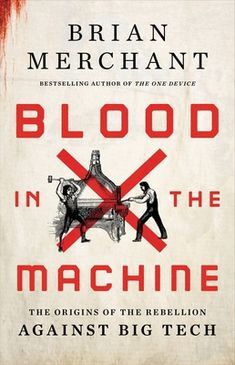
Blood in the Machine is my favourite non-fiction book that I read in 2024, and one I keep recommending to people While the subtitle is “The origins of the rebellion against Big Tech,” and the last third of the book does deal with contemporary concerns, most of the book is a in-depth historical exploration of the Luddite movement in England between 1811-1813. After you read this book, you will never again be tempted to use “Luddite” as a slur against (or a self-deprecating joke about) someone who doesn’t like or can’t use new technology. Merchant dives deep into primary sources (at least, as deep as one can in a popular, rather than scholarly, history book) to show that the original Luddites, far from having a knee-jerk anti-technology reaction, were motivated by the desire to stand up against the greed of factory owners who were introducing new technology with no concern for the impact on the lives and livelihoods of workers. The parallels to today’s situation are obvious, and may make you wish that we might see more organized labour movements and more machine-breaking today.
The Lotus Empire, by Tasha Suri

This isn’t going to be a long review, as The Lotus Empire is the third volume in a trilogy and, as is usually the case with third volumes, you shouldn’t even consider picking it up unless you’ve read the first two. If you like sweeping epic fantasy set in a world inspired by the Indian subcontinent, with two very strong and very different female protagonists who are at odds with each other but also very much attracted to each other — then you should get the first book of this series, The Jasmine Throne, and keep reading till you get to The Lotus Empire.
The main issue with finishing a trilogy is whether the author can set up a satisfying conclusion that ties off all plot points of the first two books and provides an ending that “feels right” for the main characters. Suri set herself a huge task here, since it’s clear throughout the series that any resolution that will satisfy both Malini’s and Priya’s individual goals for their nations will likely clash with each other, and will almost certainly mean they can never be together. Does Tasha Suri come up with a conclusion that will resolve the political story, the magical story, and the love story? I was not disappointed in the ending (though inevitably, invested in the characters as I was, I did have a few quibbles), but you will have to read it yourself to find out!
We Solve Murders, by Richard Osman
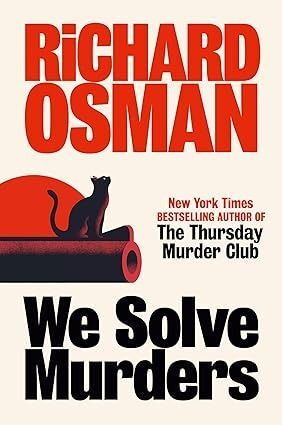
Richard Osman is back, this time not with another Thursday Murder Club mystery but with the first in a new series. Steve Wheeler is a retired police officer, recently widowed and carving out a quiet life in a small English village. His daughter-in-law Amy, whom Steve finds easier to talk to than his son, is a private security specialist who travels the world and lives for adrenaline. Together with the world-famous author Rosie D’Antonio, for whom Amy is currently working as a bodyguard, the Wheelers get drawn into a some high-stakes international thriller stuff that, frankly, I cannot remember any of the plot details of a couple of months after reading this book. I do remember that it was fun to read, with lots of twists and turns, including one that I managed to figure out before it was revealed.
As is often the case with mysteries and almost always the case with anything remotely resembling a thriller, I’m not really here for the plot, which I often have difficulty following (almost certainly says more about me than about the writer). A mystery or thriller will keep me engaged if the characters are engaging and believable, and this is where Richard Osman shines.
While he’s left (temporarily) the posh-retirement-village setting of the Thursday Murder novels behind, Osman still manages to match high-stakes action and offbeat comedy with a tender and insightful concern for grief and aging. While Steve Wheeler is considerably younger than the Thursday Murder Club protagonists, the end of his career and the death of his beloved wife has left him feeling like the big adventures and big emotions of life are over for him, and only small pleasures like the weekly pub quiz night remain. While there’s nothing wrong with small pleasures, the narrative arc of We Solve Murders (which will, presumably, continue in subsequent volumes) is as much about Steve learning to take risks and immerse himself in life again, as it is about international drug deals, murder, and money laundering. It’s the former, much more than the latter, that will inspire me to keep reading this series.
October 14, 2024
The Life Impossible, by Matt Haig
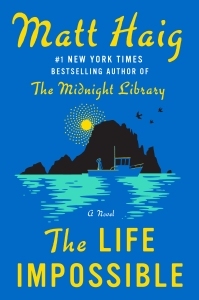
The first Matt Haig novel I read was How to Stop Time, which I liked a lot. Next I read The Humans, which was and remains an absolute favourite for me. Both novels used fantastic elements (a person who ages more slowly than normal so lives for hundreds of years, and an alien coming to earth and living in a human body) to explore very real questions about what it means to be human, and what is the value in a human life despite its limitations and flaws.
I was eager to read 2020’s The Midnight Library, but was a bit let down by it. The concept was intriguing, the execution OK, but the ending was absolutely predictable from the first page, so I felt less compelled and engaged than with the previous books. It seemed to me like Matt Haig’s desire to write inspirational, self-help-y type fiction was winning out over his desire to write fantastic stories. My review of it from 2020 (linked above) says that the concept was great and I enjoyed reading it, both of which are true, but I was disappointed. However, I still enjoyed Haig’s writing enough to immediately pick up next book, The Life Impossible, which was just released this fall.
Unfortunately, the sense of let-down I experienced with The Midnight Library was much worse with this book. It’s the story of Grace, a 72-year-old retired math teacher who is living alone in England, grieving the recent loss of her husband and the more distant loss of her son, when an unexpected bequest from an old friend sends her off to the island of Ibiza. This seems like a good set-up for a “you’re never too old to re-invent yourself and discover the joy of being alive” story, with a few mysterious elements early in the story promising some of those fantasy/sci-fi/magic realism elements that Haig does so well.
And really, this is exactly what you get: Grace goes to Ibiza, learns to live and love again, explores the mystery of her old friend’s death/disappearance, encounters mysterious paranormal forces, and discovers she can do more than she ever dreamed possible. As a plot summary, it’s not bad — though again, a little predictable. However, in this one I found the writing really let me down. The paranormal elements of the story felt far less like “Let’s explore this fascinating idea” and more like “Let’s throw a bunch of vaguely New Age-y ideas at the wall and sea what sticks.” And there were long passages, some from Grace’s p.o.v., some spoken by other characters, and some in books that she reads within the book, that are both woo-woo and preachy. Sadly, this one really failed to hold my attention the way the earlier Haig books I read did.
However, lots of people loved The Midnight Library and many readers seem to be liking this one, so if this is a new direction for Haig, it may be one that works well for a lot of his readers. I’m just afraid that, for this book anyway, I’m not one of those readers.




